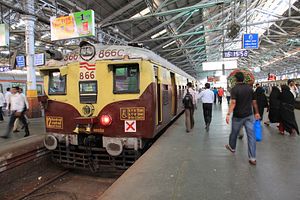The Indian government released a new rail budget this Tuesday. The budget was widely anticipated by businessmen and investors looking for hints about the kinds of economic reform that Prime Minister Narendra Modi has promised. The rail budget will be followed by a general budget this Thursday. Due to high expectations, both budgets are inevitably bound to disappoint those who are hoping for a radical shift in economic policy. India has too many competing interests to allow for such a drastic change in course. Nonetheless, as the new rail budget demonstrates, the Modi government is taking steps in the right direction towards meeting its goal of revitalizing India’s economy.
The rail budget is a reflection of two of Prime Minister Modi’s economic principles. First, its provisions and goals reflect long term strategy and are geared towards securing the future growth of India’s railways. According to Prime Minister Modi, governments in the past few decades suffered from disorderly planning done in “bits and pieces.” Modi’s new rail policy intends to correct this trend by creating institutional mechanisms “required for decision making, vision, and initiatives.”
Railway Minister Sadananda Gowda has said that the bulk of future railway projects will be financed through public-private partnerships or through foreign direct investment (FDI). Greater private sector participation would undoubtedly improve the finances of India’s railways. Experts say that India needs $334 billion of investment by 2020. India’s state owned railways have previously been hampered by years of low investment, faulty maintenance, and fares subsidized due to populist policies. As a result, the quality of India’s railways has slowly decayed despite being a state of the art network when first established by the British.
Second, Modi has often pointed out the necessity of modernizing and expanding India’s infrastructure. This would help India’s economic growth as well as improve domestic connectivity. While good roads and airports also fall under the goal of improved infrastructure, railroads are especially important due to their role in carrying freight and their affordability and accessibility to the average Indian. Railways used to handle most of India’s cargo but today they only handle one-third of it, mostly due to a congested network and slow train speeds. However, the government aims to expand the role of rail in carrying freight.
One of the most important goals for India’s railroads is the expansion of its coverage. Growth of India’s railways has been slow. In 1947, the year it became independent, India had 53,996 kilometers (33,540 miles) of routes while today it has about 65,000 km. In other words, India has added about 11,000 km of track in 67 years. On the other hand, between 2006 and 2011 alone, China added 14,000 km of track. During this same period, India only added 1,750 km in railway tracks. India has the world’s fourth largest rail network after the United States, Russia, and China. However, before 1980, India had a larger network than China.
Modi aims to reverse this trend of slow growth. Long neglected areas along India’s borders will receive more investment so as to be more tightly connected to the rest of India. The northeast region, India’s most isolated region will receive seven new trains, according to the budget. Overall, India will add 27 express trains, eight passenger trains, and at least 11 train extensions.
Technological modernization is another important goal of the new rail budget, with the particular aim of improving speed. High speed trains with speeds of up to 200 kilometers per hour are slated to go into use in select sectors. The rail budget has identified nine particularly important routes for this, including the Delhi-Agra, Mumbai-Ahmedabad, and Delhi-Chandigarh routes. In other sectors, the rail budget aims to bring trains up to the speed of 160-200 km per hour on routes such as Mumbai-Goa and Chennai-Hyderabad. Ultimately, the aim is to have a Diamond Quadrilateral bullet train network connecting all of India’s major cities, starting with the Mumbai-Ahmedabad corridor.
Finally, in addition to improving the speed and connectivity of India’s trains, the rail budget also proposed improvements in the quality of service on trains and in stations. These include better food, greater emphasis on cleanliness, and the establishment of a railways university.
Railways are the key to economic growth and connectivity in Asia in the 21st century. All over Asia, countries are increasingly building more track and faster trains in an effort to reap the economic benefits of rail. This will lead to greater connectivity and better access to markets. Although India is late to this trend, the new budget puts it on the right track to replicate the success of countries such as China in utilizing railways to improve domestic connectivity. Hopefully in the future, India will connect its high speed network with those of other countries and be able to reap the benefits of international connectivity as well.

































